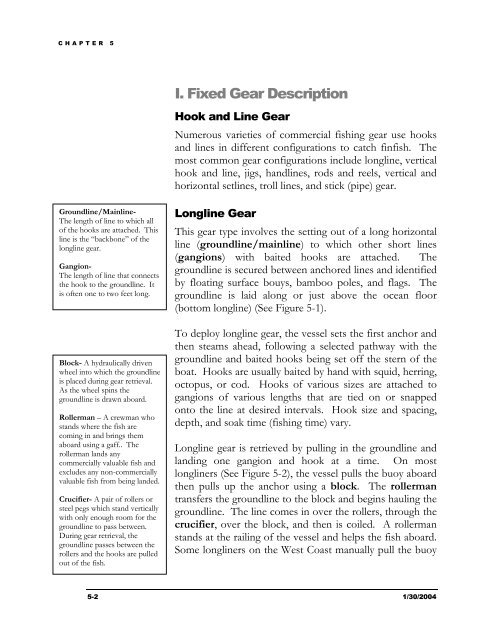West Coast Groundfish Observer Program Manual, Part2 - NOAA
West Coast Groundfish Observer Program Manual, Part2 - NOAA
West Coast Groundfish Observer Program Manual, Part2 - NOAA
You also want an ePaper? Increase the reach of your titles
YUMPU automatically turns print PDFs into web optimized ePapers that Google loves.
CHAPTER 5<br />
I. Fixed Gear Description<br />
Hook and Line Gear<br />
Numerous varieties of commercial fishing gear use hooks<br />
and lines in different configurations to catch finfish. The<br />
most common gear configurations include longline, vertical<br />
hook and line, jigs, handlines, rods and reels, vertical and<br />
horizontal setlines, troll lines, and stick (pipe) gear.<br />
Groundline/Mainline-<br />
The length of line to which all<br />
of the hooks are attached. This<br />
line is the “backbone” of the<br />
longline gear.<br />
Gangion-<br />
The length of line that connects<br />
the hook to the groundline. It<br />
is often one to two feet long.<br />
Block- A hydraulically driven<br />
wheel into which the groundline<br />
is placed during gear retrieval.<br />
As the wheel spins the<br />
groundline is drawn aboard.<br />
Rollerman – A crewman who<br />
stands where the fish are<br />
coming in and brings them<br />
aboard using a gaff.. The<br />
rollerman lands any<br />
commercially valuable fish and<br />
excludes any non-commercially<br />
valuable fish from being landed.<br />
Crucifier- A pair of rollers or<br />
steel pegs which stand vertically<br />
with only enough room for the<br />
groundline to pass between.<br />
During gear retrieval, the<br />
groundline passes between the<br />
rollers and the hooks are pulled<br />
out of the fish.<br />
Longline Gear<br />
This gear type involves the setting out of a long horizontal<br />
line (groundline/mainline) to which other short lines<br />
(gangions) with baited hooks are attached. The<br />
groundline is secured between anchored lines and identified<br />
by floating surface bouys, bamboo poles, and flags. The<br />
groundline is laid along or just above the ocean floor<br />
(bottom longline) (See Figure 5-1).<br />
To deploy longline gear, the vessel sets the first anchor and<br />
then steams ahead, following a selected pathway with the<br />
groundline and baited hooks being set off the stern of the<br />
boat. Hooks are usually baited by hand with squid, herring,<br />
octopus, or cod. Hooks of various sizes are attached to<br />
gangions of various lengths that are tied on or snapped<br />
onto the line at desired intervals. Hook size and spacing,<br />
depth, and soak time (fishing time) vary.<br />
Longline gear is retrieved by pulling in the groundline and<br />
landing one gangion and hook at a time. On most<br />
longliners (See Figure 5-2), the vessel pulls the buoy aboard<br />
then pulls up the anchor using a block. The rollerman<br />
transfers the groundline to the block and begins hauling the<br />
groundline. The line comes in over the rollers, through the<br />
crucifier, over the block, and then is coiled. A rollerman<br />
stands at the railing of the vessel and helps the fish aboard.<br />
Some longliners on the <strong>West</strong> <strong>Coast</strong> manually pull the buoy<br />
5-2 1/30/2004
















